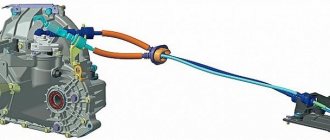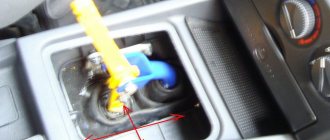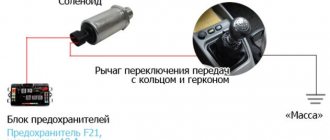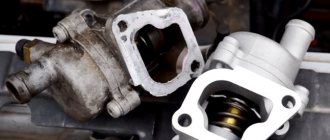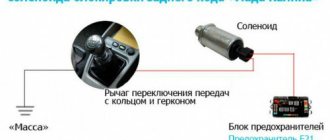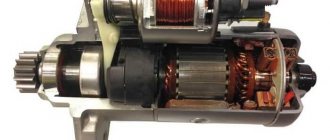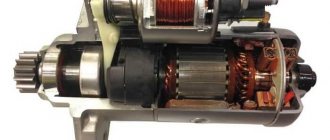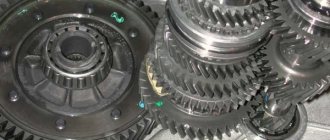Gears engage with effort: gearbox malfunctions
In cars with a manual transmission, gear shifting is done by the driver himself. Using a lever from the interior, it acts on the rocker and then on the entire gearbox mechanism. Simply put, the driver moves the gears on the shafts.
Since the shafts rotate at high speeds, cooling is required. This is done using special gear oil. Oil also protects the surfaces of rubbing parts from premature wear. The lubricant must be changed on time. On average, this is done after every 40-50 thousand kilometers.
As for the reasons for tight gear engagement, there may be several of them. However, most often they are associated with problems in the clutch or the gearbox itself. If you study the list of the most common breakdowns, then you can highlight the following:
The exception is reverse gear, since it does not have synchronizers; By the way, when the reverse gear is difficult to engage, extraneous noises, clanging, and crunching often occur. Such phenomena directly indicate wear of the gear teeth.
Gearbox linkages and rods
I remember I was “infuriated” on the VAZ 2114 by the fact that the gearbox lever was swinging from side to side like a “spoon in a glass”; I always wanted to make it stiffer, in some way. But there was only one way, to climb down the car and play with the scenes and rods. In principle, they can be released, tightened, the lever can be adjusted for tilt, etc. In general, I played around, but I noticed that if I press the lever too hard to the left, the ability to engage gear (first and reverse) disappears. This manifests itself when the car is not running, I’m already silent about the running engine.
Often the slides break, or they fly out of the fastenings, or the wear is simply enormous and they need to be replaced (this happens with high mileage). The very first thing we do is climb under the car and look at them.
What's the result?
So, the main reasons why gears are difficult to engage are problems with the clutch mechanism and gearbox. However, most of them can be eliminated yourself if you have tools, spare parts and certain skills.
Why may it be difficult to engage gears or why first gear, second, reverse, etc. may not engage? The main causes of gearbox malfunctions, recommendations.
Reasons for difficulty shifting gears with the engine running. Transmission oil and level in the gearbox, wear of synchronizers and gearbox gears, clutch.
How to change gears without a clutch: driving a manual car without a clutch in case of malfunction. Tips and tricks.
Manual transmission gears (speeds) do not engage after replacing the clutch: main reasons, settings and adjustments. Diagnosis of problems, useful tips.
Clutch: basket, release, clutch disc. Purpose and design, principle of operation of the clutch basket. How to increase clutch life.
The automatic transmission does not change gears: the car does not move forward or backward, the automatic transmission does not switch to individual gears, reasons.
Source
If you have a mechanic
Gears shift poorly in a car with a manual transmission for three reasons. The first of these is a malfunction of the clutch when it does not completely disengage (drive). The first sign of this malfunction is that the reverse gear is engaged with a characteristic crash. The rear one reacts to this anomaly more noticeably than other gears, because it is the only one not equipped with a synchronizer.
The second reason is a defect in the gear selection mechanism of the gearbox. And finally, the third is excessive wear of the gearbox synchronizers.
There are also several clutch malfunctions in which manual transmission gears shift poorly:
- Air in the clutch release hydraulic drive or fluid leakage from it. The malfunction is eliminated by replacing failed components of the hydraulic system and pumping it.
- Worn or broken clutch release fork. The part requires replacement or repair.
- Warping (runout greater than 0.5 mm) or too thick new driven disk.
- Failure of the basket (temperature deformation of the pressure plate or its distortion).
- Loss of mobility of the support bearing of the gearbox input shaft (at the end of the crankshaft to which the flywheel is attached).
- Jamming of the clutch driven disc hub on the splines of the gearbox input shaft. To eliminate the defect, clean the splines of the gearbox hub and input shaft. It wouldn’t hurt to lubricate them a little with lithol.
There is too much free play in the clutch release fork. Its value needs to be clarified with the manufacturer, since it is slightly different for different cars. Until you find out the value of this parameter for your car, set it from 5 to 8 mm. Too little free play of the fork is also undesirable, as it leads to clutch slipping and increased wear of the release bearing.
Excessive wear of synchronizers mainly occurs in those gears that are engaged more often: these are usually first, second and third. The rear one is not included in this list because it does not have a synchronizer. When your gear shifts poorly, and you assume that the reason for this is wear of the synchronizers, firstly, you should only have difficulties with this while driving. Secondly, in this case it switches better if you use double squeeze.
For those who don’t know what double squeeze is. To shift to a higher gear: depress the clutch, engage neutral, release and depress the clutch again, engage the gear.
Backlash in the so-called “helicopter” is one of the reasons for unclear gear shifting
To switch to a lower gear: double squeezing must be combined with re-engaging, that is, when the clutch pedal is released and the gearbox is in neutral, you need to press and release the accelerator pedal. This is how gears are changed in cars that do not have synchronizers. If the gearbox shifts easier using double squeezing, then the culprit for poor gear shifting is most likely worn synchronizers.
If the gears shift poorly when the car is standing still with the engine turned off, the fault may only be in the gear selection mechanism of the gearbox.
Look for damage or check that it is adjusted correctly. Don't even think about the clutch and synchronizers.
Why is it difficult to engage gears?
The problem of shifting gears while the engine is running is common, especially in cars with a manual transmission. The malfunction can occur either completely unexpectedly, or gradually, making itself known by the appearance of a characteristic grinding sound and difficulties when shifting gears. In any case, without eliminating the cause of the malfunction, you will not be able to operate the car.
For what reasons do interruptions occur?
There can be many reasons why gears do not shift when the engine is running. However, all of them, in one way or another, are connected with the two most important units of the car - the engine or gearbox. In case of serious damage, you should contact a good car service.
If the problem is in the gearbox, it will need to be removed for further disassembly and troubleshooting. If the problem is with engine components, they may need to be replaced. However, there are cases when, to eliminate a malfunction, it is enough to carry out preventive maintenance: removal, lubrication and careful adjustment of the components.
For those with automatic
If your car has an automatic transmission. It will not hurt you to know the modes in which your machine can operate:
- P – For parking and starting the engine. Switching to this mode is possible only after the machine has completely stopped.
- R – To move backwards. Switching to this mode is also possible only after stopping the car and with the brake pedal pressed.
- N – Neutral. When the engine is completely disconnected from the gearbox.
- D – Moving forward without restrictions on gear shifting (the most commonly used operating mode of the automatic transmission).
- D3(S) – Low gears for climbing and braking engines on descents.
- D2 – Mode for difficult conditions (slippery or mountainous roads). Gears above second are not shifted, that is, only first and second gears are engaged.
- D1(L) - Movement occurs only in 1st gear, used off-road on mud, snow or ice, where you need to drive without changing the throttle, and also to overcome steep climbs.
The automatic transmission also has a button on the mode shift lever with the inscription O/D OFF. When it is turned on, the inclusion is prohibited, increasing the gears of the analogue of the 5th gear of the manual transmission. That is, if your automatic machine has 4 gears for moving forward, then for more dynamic acceleration it will use only three lower gears.
About a faulty automatic transmission, an automatic transmission is much more complex than those encountered with a manual transmission, and the chances of repairing it in your garage are slim. But despite this, you still need to know something about it, if only in order not to harm it through improper use.
An automatic transmission is much more demanding in terms of accuracy in maintaining the oil level in it than a manual transmission. Both too low and too high oil levels are very harmful to her. Both of these can lead to serious damage. In both cases, oil foaming occurs. When there is a lack of oil due to the fact that the oil pump begins to capture air along with the oil. When there is excess oil, it foams on the rotating parts, which in this case are immersed in it. Foamed oil compresses better and has low thermal conductivity. Therefore, if you operate a machine with such oil, the pressure in its control systems will be low. Which will lead to slipping of the clutches and their intensive wear. Deteriorated thermal conductivity will not allow all excess heat to be removed. Which, together with low pressure, will lead to the machine failing and requiring serious repairs.
Troubleshooting methods
Once the source of the problem has been found, you can begin to eliminate the causes of the malfunction.
If the problem is in the engine
The simplest cause of problems when shifting gears can be a leak of brake fluid, which is the working fluid for the clutch. If there is insufficient lubrication in the clutch hydraulic system, it will not engage fully. Therefore, first check the fluid level in the car's tank. If the level is low, check for leaks, repair defects and bleed the clutch. When the fluid level is at the normal level, the clutch elements should be inspected.
Clutch problems
The clutch consists of three main components:
Malfunctions of these units can lead to problems with gear shifting when the engine is running.
The fact that the bearing is failing may be indicated by the appearance of a rustling or distinct hum when the engine is running and the clutch pedal is pressed to the floor. When you release the pedal, the noise should stop. When the bearing completely jams, it will no longer be possible to operate the gear shift mechanism. In this case, the unit will need to be replaced.
A faulty basket can also cause the problem. This often results from critical wear of the petals. In this case, the basket stops performing its functions when heated, and it is not possible to completely remove the pressure disk. Therefore, after removing the box, it is necessary to carefully inspect the basket for deformations and other defects. If the condition of the unit is not satisfactory, it should be replaced with a new one.
Finally, the last reason for problematic gear shifting associated with the clutch is wear or deformation of the disc and the friction linings on it.
Important! After the failed elements are replaced, during assembly the box should be centered and the clutch should be pumped.
The problem is at the checkpoint
The most common cause of a gearbox malfunction is wear of the synchronizers. You may have previously been warned about this by a characteristic crunch when changing gears. Synchronizers that smooth out the angular speeds of the shafts are usually made of copper and are therefore subject to wear.
Much less often, the gearbox shafts themselves can fail. In this case, a separate transmission may not be included. The degree of wear and the need for replacement is also determined after dismantling and disassembling the transmission.
Important! To eliminate faults that have arisen in the box, a major overhaul may be required, which is not cheap and does not happen quickly. Therefore, you need to be prepared for the fact that your car will be delayed in service.
However, you should not immediately think about the bad. Sometimes a problem with gear shifting can be caused by a lack of oil in the gearbox. Loud noise while driving or a metallic grinding sound in the box may indicate insufficient oil level. If there is a complete lack of oil, you will not be able to change gears at all: the synchronizers will not function properly. Changing the gearbox oil is recommended every 60-80 kilometers.
In addition to checking the oil level in the gearbox, you will also need to inspect the unit body for damage and the absence of lubricant leaks through the gaskets and seals.
Reverse gear does not engage on a viburnum - how to solve the problem yourself?
Drivers can diagnose many problems with reverse gear on Lada Kalina and then fix them with minimal time losses with their own hands.
To do this, it is not at all necessary to contact a car service center and pay money for the services of specialists. If the reverse gear on Kalina, beloved by domestic motorists, does not engage, there is no need to immediately go to the technical center. Usually such a problem is solved in a couple of hours in a private garage. Often the reason for the incorrect behavior of the iron horse of the brand we are interested in is a faulty electrical wiring in the gearbox (gearbox).
On Kalina, reverse gear is started by retracting the gearshift lever and locking it in first gear. After performing these actions, the solenoid in the box is activated.
Its task is to redistribute the gears so that they effectively transfer the load when rotating against their axis (that is, to ensure driving at reverse speed).
If, after an independent examination, it suddenly turns out that the malfunction is due to the electrical wiring in the gearbox, then there is a chance to solve the problem without resorting to the help of a qualified service
In fact, the car, working in first gear, moves in reverse due to a special additional gear connected to the mechanism of the levers. This simple circuit stops functioning in cases where the wires in the specified solenoid become rotten. This problem can be solved simply:
- Turn the front left wheel all the way (to the side).
- Raise the hood.
- Using a 36 key, release the special washer that tightens the solenoid housing. We carefully dismantle it.
- Blue and yellow wires come out of the housing. They may be responsible for the fact that the reverse gear does not work.
- If we see that the wiring is rotten or covered with a thick layer of moisture and oil, we change them.
- Reinstall the solenoid housing.
- We start the Lada Kalina, drive 20–30 meters in first gear, and engage reverse.
The entire procedure described takes approximately 40–50 minutes. But sometimes the actions taken do not solve the problem. Then it makes sense to check the operation of the switch button.
The wires leading to it also rot quite often. We remove the rubber gasket and the lever itself right in the cabin. We inspect the switch for faulty wiring.
If there is one, we replace the damaged wiring.
After dismantling the lever, be sure to inspect it for signs of corrosion. Very often, ingrained rust stops the switch button, preventing you from engaging reverse. We remove the corrosion, put the lever and gasket back. Let's try the back one. If after this it does not work, we look for other reasons causing the malfunction.
Let's consider other common reasons that do not allow the use of reverse gear on regular and tuned LADA Kalina 1 and LADA Kalina 2. The reed switch may have flown. The functionality of this element is easy to check.
We dismantle the decorative casing above the lever in the car interior and look for its connector. We remove the last one and close the contacts.
This operation can be performed using a piece of wire, a paper clip, or any other suitable device at hand.
After mechanically closing the wiring, we try to turn on the reverse gear. If the problem is solved, leave everything as is. We're going about our business. And at the first opportunity we go to a car service and completely change the reed switch.
It is impossible to operate a car with the wiring connected according to the specified diagram for a long time.
Note that failure of the reed switch is most often caused by rotting of its contacts or the entry of small particles of dirt and debris into the mechanism.
It is impossible to predict the complexity of a breakdown in advance based on sensations alone, so you should not make hasty conclusions
If the reverse gear is engaged, but the driver does not hear the characteristic sound with which the additional gear comes into operation, we can safely say that the release bearing is faulty.
It usually breaks due to metal filings or waste oil that has penetrated the gearbox mechanism. These pollutants increase the friction force. This causes rapid wear of the bearing, and in some cases leads to combustion of the entire mechanism.
The described problem can be solved in one way - you need to install a new bearing.
We have already told you how to replace the wires leading to the solenoid. Now let's look at the rules for repairing the Kalina locking mechanism. Its malfunction makes it impossible to turn on the rear. To perform this type of repair, you need to look at the solenoid control circuit. It is given below.
Failure of the mechanism in most cases is caused by the failure of fuse F21 (it is rated at 10 A). Through it, as can be seen in the diagram, 12 V is supplied to L1 (solenoid). Then S1 (switch) closes the circuit to ground. As a result of this, the solenoid coil is activated.
If the fuse is blown or the switch is faulty, reverse gear will be locked. Let's solve this problem. We take out the fuse (if you look at the left, it will be the eighth one), and check it with a multimeter. Instead of the faulty element, we install a new one (of strictly the same rating - 10 A).
New Lada: Universal electric power steering control unit for Kalina, Granta, Granta FL, Kalina 2, Datsun
When F21 starts working, we work on the switch (see the first section of the article).
If replacing the switch and fuse does not produce results, remove the connector from the solenoid. We put regular pins in it (two pieces). We measure the voltage with a multimeter.
With a normally operating mechanism, it is equal to 12 V. If the readings are different, we have a break in the electrical harness on the pallet - at the place where the clamp is mounted. We pull out the entire harness, expose the wires, and eliminate the break.
We solder the twisting area and treat it with heat shrink for greater reliability.
In very rare cases, the solenoid itself breaks down. You can check if it is faulty with a multimeter. We connect the device to the solenoid and measure the resistance. If we see a value other than 2.2 Ohm, we will have to change the element. The work is not difficult, but quite dirty.
You will need to drain the oil from the gearbox, then remove the old solenoid and install a new one. Before installing a working element, be sure to treat the threads with sealant. It is important. Without this procedure, oil will soon begin to seep through the threads.
If the described methods for restoring the normal functioning of the gearbox did not help, most likely we encountered problems in the mechanical part of the gearbox:
- the spring burst;
- the retaining bolt has been cut off;
- The device that secures the gearbox elements has broken.
These faults are truly complex. Such problems must be solved by car service specialists, since they will need to remove the gearbox, disassemble it, find the cause of the breakdown, and then fix the problem. All this takes more than one hour and requires the use of special tools. It is irrational to carry out such repairs at home.
Gears are difficult to engage: causes, solutions
With the car running, first gear became difficult to engage. Reverse gear engages with a crunch, as if the clutch is not fully depressed. If you apply the gas several times, first or reverse gears are engaged. Starting today I start in second gear. When the car is turned off, all gears shift normally and easily. Today I stopped by Shabashkin’s office, they announced: Replacement of the clutch kit – 4,000 rubles + 6,000-10,000 rubles. the cost of this kit. Expensive. Tomorrow I want to go to another, expensive service, I’ll listen to what they say. What thoughts does anyone have? PS I would like to know the part numbers for the clutch kit for my car, can anyone help me with this? In our area the prices are sky-high, I want to order from Exist.
Just arrived from the service. The masters said: if the rear speed crunches, change the clutch 100%. The price was announced on the street as 2000 rubles, when they took it up on the lift, the price increased to 2400 rubles, I don’t know why. Then they told me to go home and film for three hours. They called for lunch, come. I saw the disassembled clutch assembly and said to replace it in its entirety. The box was removed for the first time (the words of the master). After 13 years of operation, this is not a bad result. Ferrido was eaten down to the rivets, the rivets began to shuffle along the basket disk. All the tabs on the basket were intact, but the basket disk had circular purple stripes, which indicated that the clutch was not pressed or was slipping. There was no “pocket” on which the rod rests, it was torn off, along with the rivet. The old rod was shorter than the new one I brought by 2 mm. When replacing the support bearing, half a liter of oil spilled out! One day they found two places where antifreeze was leaking. From under the thermostat cover (I bought a new one) and from the pipe that goes to the recently installed gas equipment reducer. As luck would have it, I forgot my camera and cell phone at home today, no photos. I hope to take pictures of everything tomorrow for the report, but perhaps by then the box will have already been delivered.
About costs: SACHS clutch kit – 6,000 rubles. + support+rod+stage seal – 1000 RUR. Thermostat cover – 200 rub. Oil for box 1l. – 500 rub. Clutch replacement work – RUB 2,400. The work of replacing the thermostat cover and the rocker seal - 500 rubles (I bargained for 200 rubles).
And that: 10,600 rubles.
The number of my oil is this: VAG G 060 726 A2 They will add half a liter of this to me: Castrol 4008177071775 Syntrax Universal Plus They have the same API specifications GL-4
The reason was a broken penny, which is not in photos 1,2 and the old rod (pusher) was 2 mm shorter than the new one, which is why the clutch was underloaded by 4-5 mm. The basket was in normal condition, only it had purple circular rings, which indicated that it was overheating. Ferrido was already “fit”, the opening was on time, on one side it was worn down to the rivets. The condition of the support bearing is normal, I changed it a bunch.
The gearbox is a complex mechanism that requires constant maintenance. Including regular diagnostics and oil changes. Ignoring these measures often leads to problems with gear shifting.
Video “Repair of the gear shift unit in a VAZ car”
This video shows the process of repairing a gearbox in a VAZ car. The instructions are general and suitable for Kalina cars.
Starting from the end of 2012, on LK1 and further on LK2, AvtoVAZ began installing modernized cable gearboxes.
I am the owner of cars with different transmissions on the Lada Kalina and I can say that there really is a difference. When buying a car with a cable transmission, at first I didn’t know whether to be happy or sad. There is a different handle here and the reverse gear is engaged differently. In general, it's all a matter of habit. Having driven the first thousand kilometers with the new gearbox, I still want to note that the gears are switched on better, more clearly, let’s say, more comfortably. There were some minor issues engaging reverse gear, but that doesn't bother me. I discovered a big advantage from using the new box in winter. The gears shift just as well as in the summer. No need to wait for the oil to warm up. On the old gearbox, in the first kilometers in winter, the gears engaged very slowly. More differences. The new box does not have a dipstick to check the oil level. Just no, that's all. Apparently AvtoVAZ decided that this was a relic of the past (?). The amount of oil required for a change is 2.3 liters, and last time it was 3.5 liters. Now about the sad stuff. The howl was there and remained. Some people apply the term "trolleyness" to second gear. Changing the oil to semi-synthetic and synthetic does not change this for the better. I have not yet read that someone has qualitatively solved the problem with the howling gearbox on Kalina. In July 2015 (the car was only 2 years old), my cable box gave me a “surprise”. I had to skid a little on the sandy road. Moreover, the situation was quite normal, without heavy loads on the car. Friend kleonid1965 can confirm this. After this, the second gear began to engage with a knock, some write with a “crunch.” Moreover, the higher the speed, the stronger the impact of the gears at the moment of shifting gear to second. Driving began to cause discomfort. For myself, I determined the conditions under which it was possible to get rid of the “crunch”. Firstly, it was possible to switch to second only at low speed (10-15 km per hour). Secondly, do not use second gear at speeds of 20-25 km per hour and above, that is, maneuver between 1st and 3rd gears. In addition, it was possible to avoid gear knocking if the transition from 1st to 2nd gear was through neutral, that is, from 1st to neutral, then from neutral to 2nd. Switching to second gear turned into terrible discomfort. On the one hand, if you drive as usual, then knocks and knocks at 2 indicate an obvious malfunction of the gearbox. On the other hand, if you tried to avoid the “crunch,” you had to slow down once again to shift or drive tight in 3rd gear. The reason for all this misunderstanding is wear of the second gear synchronizer. I would say that this is a clear miscalculation of the engineers at the AvtoVAZ plant. Components such as the gearbox should not be faulty 2 years (about 30 thousand km) after purchasing a new car. Some may envy my patience, since I drove with such a malfunction for about 10 months. During this time, I studied the issue and finally found a workshop where they not only changed the synchronizer, but the entire 1st and 2nd gear gears with their synchronizers from the fret of the 10th family. Special thanks to the car owner with the nickname Kalina for the consultation. The process of repairing the box lasted for several hours. To remove the box, it is necessary to remove a considerable number of elements, both from above under the hood and from below under protection

